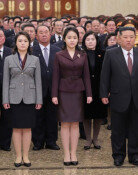[Opinion] Equality Consciousness and Noble School
[Opinion] Equality Consciousness and Noble School
Posted February. 26, 2002 10:16,
According to an opinion poll conducted by the Korean Educational Development Institute in October 2000, more than 70 percent of the people in Gangnam, Bundan, and Ilsan, most of them are highly educated, supported the equalization of the education system. Based on this poll, the education authorities expanded the equalization system to the newly developed cities in the Metropolitan area. Therefore, the students who were assigned their schools through the computerized allotment without entrance examinations will enter into the Bundang Suhhyun and Ilsan Baekseok high schools, which are newly-rising leading schools, from next month.
The Ministry of Education and Human Resources Development (MEHRD) insists the result of the poll as a basis for its maintaining of the equalization system. However, 70 percent of support does not mean that the equalization system is a fully successful policy. The support rate for the equalization system in Bundang and Ilsan is roughly identical with the parents` rate whose children are enrolling at the ordinary high schools.
In the `vision 2011` report, the Korea Development Institute (KDI), a think tank of Korean economy, suggested a full reform plan of the high school equalization system and it stirred hot debates. The essence of the KDI`s plan is returning the student selection right to the private schools to attract the wealthy classes` demand and intensively investigating the national finance to the public schools.
The private schools in America, England, and Japan are not interfered with the governments in school management, such as the selection of students and the appropriation of school fees. Even though the school fees are expensive, the education qualities are excellent and the students` entering rates into the distinguished universities are high. In Japan, the private schools` expenses are 8 times higher than those of the public schools. In America, the private schools` fees are 20,000-30,000 dollars annually, and thus, students from the wealthy classes can enter into the private schools.
The equality consciousness, which is deeply rooted in Korean minds, does not allow the establishment of such noble schools. And, it is also practically difficult to release all the private schools from the equalization system because the rate of the private schools in Korea is very higher than those countries. The private schools are 10-13 percent in America and about 10 percent both in England and Japan. That of Korea is 47 percent.
Pushing the responsibilities of all education problems off into the equalization system is a kind of witch-hunting after idling the investment into the education as the last level among the countries of the Organization for Economic Cooperation and Development (OECD). The opinion that a choice can solve all problems is a viewpoint of the market supremacy. Sometimes a market fails, and there is no market in which a perfect choice is guaranteed.
Before the launching of the equalization system, the high school entrance examination was excessively competitive and distorted the normal education of the junior high school. While the situation has been changed after the introduction of the equalization system 28 years ago, it is hard to say that all education problems of that time have solved now.
Although the KDI`s suggestion contains the defect of oversimplification, the education circle needs to listen some points which are based on economic logic. A Communist method, which extremely regulate the choice, will lead inevitably a downward equalization not only in economy but also in education.
While there is a demand for the high quality education, it is not supplied in the country. Therefore, parents send their children to the foreign countries in spite of their suffering of separation. If the government can draw the enormous amount of money for the private education into the public education and can prevent the leaking of dollars for children`s studying abroad, it is considerable to establish the independent private high school or noble school whatever it is named. If 10 schools are not enough, the government needs to allow 100 schools according to the market demand. If the consumers take 100 percent of financial responsibility in these schools, the government can investigate the national finance fully into the public schools, and the masses can receive the benefit.
The MEHRD announced its plan to complement the equalization system through the expansion of the independent private high schools. But there are only three independent private high schools in the country, and they already have been selected students independently in the non-equalized areas. There will be two more schools in next year. It is too slow. It will take too much time until every city and county have two or three independent private high schools.
The Ministry does not have a consistent principle on the equalization system. The ministry has swung between the reduction and expansion of the system for last 28 years. After abolishing the high school entrance examination in the newly developed cities of the Metropolitan area justified with a public opinion, the Ministry even failed to allocate the students. There have been 7 ministers for last 4 years, and none of them had enough time to do something. A minister who pushed the plan to establish the independent private school resigned shortly after he had faced the opposition from the Seoul Metropolitan Office of Education.
As the `vision 2011` indicated, the driving force for the economic and social developments is the human resources in the knowledge and information age. The quality and quantity of the human resources decide the national competitive power and quality of life. Without overcoming the uniform and rigid structure of education, a country cannot obtain the qualitative competitive power of human resources. If we hesitate again, ten years will pass quickly.
Hwang Ho-Taek (Editorial Member)
hthwang@donga.com




![전기매트 틀고 자면 몸에 전자파 쌓인다?” 직접 측정해보니 [알쓸톡]](https://dimg.donga.com/c/138/175/90/1/wps/NEWS/IMAGE/2026/01/02/133079758.3.jpg)


